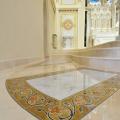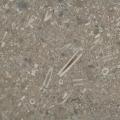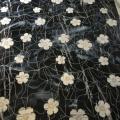Stone in interiors : And the winner is… the client
The stone industry has adopted man-made products just as the tile industry has encompassed natural stone. The winner has been the client, as this month’s tile awards (being presented on 14 May) show.
Projects shortlisted for the Tile Awards, being presented this year at an Awards Carnival in St John’s Hotel, Solihull, on 14 May, have once again highlighted some spectacular stone interiors, including that of the Taymouth Castle renovation.
Taymouth Castle is on the shores of Loch Tay, at the gateway to the Scottish Highlands. It is a stately home that has had many millions of pounds spent on converting it into a hotel and golf course.
The man hoping his tiling at the castle is going to earn him the title of Tile Fixer of the Year and/or the Award for the Best Use of Tile in the Leisure/Hospitality Sector is Wes Geraghty, who learnt the trade from his father, Joe, and worked for Fired Earth for three years before returning to the family business of Geraghty Tiling.
Joe Geraghty won a Tiler Of The Year Award in 1987 and Wes would like to follow in his footsteps.
Wes was supposed to start working at Taymouth Castle in 2011, but the developers shelved the project. It got going again three years later under new ownership and Wes returned to carry out his work.
Taymouth Castle as it is seen today is mostly Victorian, built by the Marquis of Breadalbane so he could entertain Queen Victoria and Prince Albert. But a castle has stood on the site since 1550, when Sir Colin Campbell built what was then called Balloch Castle. It became the seat of the Campbell Clan whose lands, at the height of their powers, covered more than 100 miles from Taymouth to the West Coast of Scotland.
Geraghty Tiling is a family business started by Wes’s father, who also had a tile shop in Perth until he retired in 2008. Wes’s son, Lewis, now also works at Geraghty Tiling, as does Wes’s older brother, Nick.
The interior designer for the latest work at Taymouth Castle was architect Peter Inston, Managing Director of Adatto.
The idea had been to use Carrara marble throughout but there were concerns about the weight that the stone would add to the upper floors, and in particular the damage it might cause to spectacular retained, 200-year-old ceilings on the ground floor. One of the ceilings, in what is called the Queen Victoria Library, has been valued at £10million alone.
So while 20mm thick Carrara marble was used on the ground floor in 300mm and 400mm square tiles, on the floors above an 8mm thick porcelain Carrara lookalike 300 x 600mm was used, although with genuine impression that it is the natural material throughout.
Wes says the porcelain is printed with the Carrara veining 100m2 at a time, so there is little chance of seeing a pattern repeat.
The use of natural stone tiles is accepted across the interiors sector these days and the mixing of natural stone and man-made products is not so unusual, although tilers need to understand the differences there can be between natural stone and ceramic tiles.
It was stone that led the way in larger format tiles, although the porcelain manufacturers have quickly learnt to follow suit. As tiles got bigger, many natural stone tile producers started adding a mesh backing for strengthening as a precaution. For some, that has now become standard practice and both Stone Federation Great Britain and The Tile Association (TTA) have issued warnings about using standard tile adhesives with mesh-back stone tiles.
They reiterated those warnings last year after mesh-back stone came adrift in bathrooms at the luxury Shangri-La hotel in The Shard in London. The problem delayed the opening of the hotel and formed the bulk of a claim of £57million against contractor John Sisk & Son by the Hong Kong-based hotel chain. The claim was eventually settled out of court for an undisclosed sum.
Wes Geraghty says being a small business and a member of TTA (which runs the Tile Awards) he refuses to work for anyone who will not accept his recommendations for fixing tiles. He says he favours using Schluter tanking and backing boards and Raimondi levelling clips for floors.
He says he won a job at Gleneagles. There were over £100,000 worth of tiles on an anhydrate floor. He would not lay them without using a Ditra mat because he anticipated trouble if he did. The client’s team did not want to use Ditra, but in the end they accepted Wes’s arguments for why it was necessary.
Schlüter Ditra 25 is a grid structured polyethylene membrane with an anchoring fleece laminated to its underside. It is for tile and natural stone installations, serving as a waterproofing membrane, a vapour pressure equalisation layer to accommodate moisture on the underside of the substrate and an uncoupling layer for problematic substrates.
The tiles at Gleneagles were 1200 x 1200mm covering 600m2 of floors as well as being used in seven bathrooms. Wes wanted to enter that for an award but it was for a private client who did not want it pictured.
Geraghty Tiling carry out domestic and commercial work in the area around their base in Perth and go further afield for commercial work, especially car showrooms, which Wes particularly likes doing. “We’re pricing a lot of commercial jobs in England at the moment,” he told NSS.
Wes Geraghty’s project at Taymouth Castle that he has entered for the Tile Awards this year is impressive, but for the Fixer of the Year title he is up against six others who also believe their work should win them the title, which is not based on the size of the project but the quality of the work. As the Tile Award judges always say, determining the winner among so much high quality work is never easy.
Another of the shortlisted entrants is David Stott. He has been voted Tile Fixer previously and is hoping to set a record by becoming the first person ever to gain the accolade twice. He has been proposed by BAL for seven wet rooms he tiled in a private house last year. The master bathroom was all in Carrara marble, matt on the floor and semi-finished on the walls, but there were various products used throughout the scheme, including hexagonal porcelain tiles in one of the bathrooms.
One of the finalists in another category – that of Best Use of Tile in a Commercial Contract – has the most spectacular use of natural stone of all the entries in all the categories. For this magazine, at least, it is the stand out project from the 2016 Tile Awards. It is the renovation of St Patrick’s Church in Donaghmore, County Tyrone in Northern Ireland, entered by Armatile.
Established as an independent tile retail outlet in Armagh in 1975, Armatile has developed into a leading retailer and distributor in Ireland, with showrooms now in Newry and Belfast as well as Armagh and a 6,000m2 warehouse.
But the main element in Armatile’s growth has been the purpose-built manufacturing plant it opened in Armagh in 2000. It has some of the most advanced cutting technologies the tile industry has to offer, including two waterjets, which have played a significant role in insetting words and designs into stone floors, as they did for St Patrick’s in Donaghmore.
Armatile’s project management team works with leading designers and architects throughout Northern and Southern Ireland on all kinds of projects including churches, cafes, swimming pools and shopping centres.
Armatile has been involved in some of the most recognised projects in Ireland of recent years, including St George’s Church in the centre of Belfast, The K Club golf course in County Kildare, The Europa Hotel, Peter Mark’s Training & Creative Centre in Dublin and the stunning St Patrick’s Cathedral in Armagh. To that list can now be added St Patrick’s Church in Donaghmore.
We will bring you more details and pictures of St Patrick’s in the next issue of Natural Stone Specialist magazine, when we will also report on the winning projects, products and people in the Tile Awards, which will have been presented by then.
If you want to book a place at the Awards black tie dinner in Solihull, you can do so, as long as there are any seats left, on the Awards website at www.ttaawards.com.
Ian Crowther, who is the de facto chairman of the judges as the chairman of TTA Marketing Committee, which organises the Awards, told Natural Stone Specialist: “This year we have had some really fabulous entries – there have been a lot of quality fixers and quality work put forward. They really give you the ‘wow!’ factor. It is probably some of the best I have seen in my time in the industry – and that’s 30 years!”
Ian is the Northern Operations Manager of N&C Nicobond, the national manufacturer and distributor of tile adhesive systems, ceramic, porcelain and natural stone tiles, operating from seven distribution centres across the country. He was one of the founders of TTA when it was formed from the amalgamation of several organisations from the sector 12 years ago, and has been involved in each of the annual Awards competitions.
“What we have seen over the years is more and more entries involving stone, more and more large format tiles and more and more products trying to emulate the look of natural stone but with the ease of installation and cleaning of ceramics.”
Lately, he says, a wood look has become fashionable and is replacing some of the stone finishes on ceramics, although Ian says in his own house he has natural limestone, which he describes as providing that “real quality finish” that gives natural stone the edge.
He says tile product suppliers have all spent money on improving their products and that training in the use of those products has also improved. “The best way to describe it is a move from brown chip to blue chip,” says Ian.
And, of course, the internet has helped. There are now videos providing quick answers to just about everything – because everyone wants instant answers. Inevitably younger people coming into the trade think they know it all and have nothing to learn from those with experience. While they are wrong, sometimes those who have been in the trade a long time do not realise how much products and materials have moved on, either, says Ian.
Another of the judges, Steve Whitehurst, was on the panel for the first time this year. He told NSS: “The project categories were especially diverse and of a high standard. There were several notable projects using natural materials in combination with designer porcelain tiles.
“As a first time judge I was particularly impressed with the entrants for the trainee fixer of the year. It is reassuringly pleasing to see that the training colleges and apprentice schemes are turning out very capable and promising young tile fixers.”
Waterjet inlay from Armatile
 Manufactured by Armatile, Armagh. Italian white Carrara Marble Slabs were chosen for the central piece of each design and surrounded by a bespoke border depicting vines and leaves, incorporating warm tones of Sienna, Rojo Alicante and Alpi Verdi marbles.
Manufactured by Armatile, Armagh. Italian white Carrara Marble Slabs were chosen for the central piece of each design and surrounded by a bespoke border depicting vines and leaves, incorporating warm tones of Sienna, Rojo Alicante and Alpi Verdi marbles.
The rare and beautiful from the Marble & Granite Centre
The Marble & Granite Centre is the exclusive distributor of the new sintered Lapitec, available in a wide range of colours and now offered in seven finishes. The colour collection comprises of contemporary pale and earthy colours commonly found in natural stone, as well as styles which mimic veined marbles and stone.
New finishes include: Lithos - a finely textured surface which mimics natural sandstone; Arena - a sandblasted yet smooth finish with a regular grain; Dune - A new, smooth textured surface in undulating patterns much like sand dunes.
These finishes have been developed by Lapitec at their Italian headquarters in response to customer demand and to reflect the product’s synergies with nature.
Lapitec is also constantly updating its colour palette to keep pace with trends in interior and exterior design. The latest colours are: Arabescato Michelangelo, adding to Lapitec's range of veined materials; Arabescato Michelangelo, available in Lux, Satin and Lithos finishes; Artico, an to addition to Lapitec's range of whites; Moca, which joins the Lapitec range of 12 plain colours. Moca is available in the full range of seven different finishes.
 The Marble & Granite Centre stocks a wide range of stone products, including one of the UK's most desirable and exclusive limestones, Mandale Derbyshire Fossil.
The Marble & Granite Centre stocks a wide range of stone products, including one of the UK's most desirable and exclusive limestones, Mandale Derbyshire Fossil.
With a naturally variegated colour that can range from a grey blue to brown, and its dense coverage of a fascinating variety of fossils, this limestone creates a dramatic and stylish surface material.
Mandale Derbyshire Fossil was unavailable in slab form in the UK for many years, but was reintroduced to the market by The Marble & Granite Centre Ltd in 2014.
It is offered with a polished finish to highlight the fossils and is in stock in a variety of slab sizes.
The Mandale Derbyshire Fossil lies on the Chatsworth House estate in the heart of the Derbyshire countryside. The small quarry has been producing materials for hundreds of years; with records of stone production going back well into the 18th Century.
Chatsworth House itself has a range of fine examples of the material’s use and it also appears in many other well know British interiors including the Natural History Museum, Hereford Cathedral, the V&A and The Royal Festival Hall.
Waterjet inlay from stoneCIRCLE
 Waterjet cutting makes inlaid work on floors like this more affordable. The work above was produced by stoneCIRCLE at its 2,800m2 factory in Basingstoke for a private client in London. The intricate inlaid polished marble floor has a ground of Nero Marquina marble inlaid with Venato Fantastico flower petals and stems and Botticino Classico centres to the flowers. Venato Classico was also used to create the feature joints in the design.
Waterjet cutting makes inlaid work on floors like this more affordable. The work above was produced by stoneCIRCLE at its 2,800m2 factory in Basingstoke for a private client in London. The intricate inlaid polished marble floor has a ground of Nero Marquina marble inlaid with Venato Fantastico flower petals and stems and Botticino Classico centres to the flowers. Venato Classico was also used to create the feature joints in the design.
Unique Calacatta in quartz from Compac
 Marble is beautiful but it is vulnerable to etching and staining, which is why it is more common to see granite worktops in kitchens. But the vulnerability of natural marble has presented an opportunity for the manufacturers of engineered stone to come up with materials that perform as well as granite but have the look of marble.
Marble is beautiful but it is vulnerable to etching and staining, which is why it is more common to see granite worktops in kitchens. But the vulnerability of natural marble has presented an opportunity for the manufacturers of engineered stone to come up with materials that perform as well as granite but have the look of marble.
One of them is the Unique Calacatta pictured above just launched by Compac.
It is a quartz worksurface with contrasting grey veining on a white background, giving it the aesthetic of the marble from which it takes its name in a resilient, waterproof, hygienic product. Just as in nature, the pattern on each slab is unique.
It can be used in private homes and public spaces alike to give the elegant serenity and harmony of light marble without concerns about its durability, enabling architects and designers to specify this new finish with confidence.
The physical properties of quartz, along with its ever expanding range of colours and patterns, continue to expand its market share – and not just for worktops nor just for kitchens, but also for floors and walls throughout domestic and commercial properties.
Quartz has become a staple in the range of products offered by stone processors and many say sales of it far outstrip sales of natural materials these days.
New materials from Granite Granite
 Over the past few years stone wholesaler Granite Granite Ltd has been expanding into new products from its core range of natural granite and marble. First it added Quarella quartz. This year it has added Laminam porcelain, the first stocks of which have just arrived. And now, in an exclusive deal, it introduces Cambria quartz from the USA.
Over the past few years stone wholesaler Granite Granite Ltd has been expanding into new products from its core range of natural granite and marble. First it added Quarella quartz. This year it has added Laminam porcelain, the first stocks of which have just arrived. And now, in an exclusive deal, it introduces Cambria quartz from the USA.
The deal with the Americans of Cambria has already generated a lot of interest ahead of the arrival of first stocks this month (May). Initially, Granite Granite will stock 24 of the 126 available designs, although any of those not in stock in the UK can be specially ordered and delivered in approximately four weeks.
To accommodate its expanding stocklines and sales, Granite Granite has now acquired new premises that not only give it a vast warehouse but also a showroom where customers will be able to come and see the extensive range of products offered by the company.
Cantilevered staircases from Chichester Stoneworks
 You can understand the attraction. Winding, cantilevered stone staircases have become must-have features in the best houses and require all the traditional skills of stonemasonry to engineer, make and install. Those pictured here are from Chichester Stoneworks.
You can understand the attraction. Winding, cantilevered stone staircases have become must-have features in the best houses and require all the traditional skills of stonemasonry to engineer, make and install. Those pictured here are from Chichester Stoneworks.
The best advice is to seek the best advice
 By Lisa Breakspear, Sales & Technical Director, Fila UK
By Lisa Breakspear, Sales & Technical Director, Fila UK
Stone has become more and more popular over the years and, as with all natural materials, so too have the replications. Remember the famous Coco Chanel quote: “If you want to be original, be ready to be copied.” But porcelain and ceramic effects and natural stone differ greatly, as do the care regimes that should be adopted for each. And while there’s now much more information readily available about how to care for stone, the biggest issue with natural stone remains the use of unsuitable maintenance products.
Stone is a fabulous material and it isn’t difficult to look after. The best advice is to seek the best advice! In general, stone should be sealed at the point of installation – but only after it has been thoroughly cleaned. From there on, it’s just a question of using cleaning products recommended for stone.
Unfortunately, lots of people still reach for general householder cleaners. These tend not to be pH neutral and stone does require maintenance with a neutral product. When incorrect products are used, they can damage the sealant, which renders it ineffective and could eventually lead to damage of the stone itself. For example, the use of an alkaline cleaner on a polished natural marble can damage the polished finish. A suitable pH-neutral cleaner, on the other hand, will protect the sealant and the surface of the stone, so it will remain easy to clean and will retain its original aesthetic.
Just as the choice of stones and finishes on it have increased, so have the treatment options. Solvent-free sealants, like FILAMP90 Eco Plus, now offer the same performance benefits as solvent-based formulas, but with a safer, fume-free application. A single application is sufficient and water-based solutions can be applied over residue moisture, so you don’t have to wait until tiles are bone dry before applying it. This can cut application time by up to 80%.
It’s worth reiterating that if you seal a stone floor that hasn’t been properly cleaned you will effectively sandwich fixing residues and dirt between the stone and the sealant. Not only will this compromise the aesthetic of the stone, it can also impair the sealant’s performance, as the sealant won’t be able to use the stone’s porosity to do its job. A quick swill with a bucket of water and a mop will not remove this dirt, either. It is imperative that a recommended initial cleaning product is used.
In terms of cleaning and maintenance, many consumers find purchasing multiple cleaning products disagreeable, even confusing. They would rather use one product to clean all of their surfaces than have to keep checking they are using the right product and changing their mop bucket several times. But most recommended stone cleaners can be safely and effectively used on ceramics and porcelain – but not vise versa because non-specialist products can be either too alkaline or too acidic for use with stone. Concentrated, specialist universal formulas, like Fila Cleaner, provide a solution because they can be used at different dilutions for different applications, providing a safe and effective clean across all surfaces.
There is a lot of good advice out there, but things can still go wrong. If they do, there are now some great products available to rectify most problems. For example, one of Fila’s latest launches is a product called Fila No Rust, which can safely remove oxide staining from even the most sensitive stone. It simply dissolves the rust mark without altering the stone’s natural appearance in any way. So, the advice is out there. So are the products – it’s simply a case of using the right ones.
